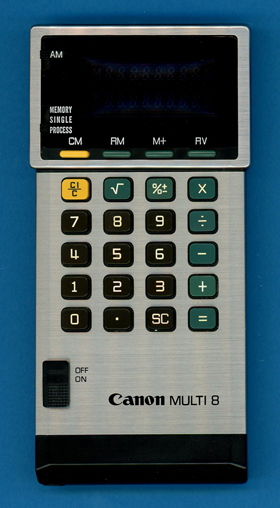
DATAMATH CALCULATOR MUSEUM
 |
DATAMATH CALCULATOR MUSEUM |
Canon Palmtronic MD-8 aka MULTI 8
| Date of introduction: | 1977 | Display technology: | Fluorescent |
| New price: | Display size: | 8 + 8 | |
| Size: | 6.1" x 3.1" x 0.90" 156 x 78 x 23 mm3 |
||
| Weight: | 5.6 ounces, 159 grams | Serial No: | 778058 |
| Batteries: | 3*AA | Date of manufacture: | mth 12 year 1977 |
| AC-Adapter: | Origin of manufacture: | Japan | |
| Precision: | 8 | Integrated circuits: | TMC1079 (KBSLΔ7745) |
| Memories: | 1 | Displays: | Futaba 20-ST-22 |
| Program steps: | Courtesy of: | Joerg Woerner |

![]()
 Canon
introduced already in 1977 with this Palmtronic MD-8 aka MULTI 8 the first pocket calculator using a two-line display.
A sliding switch to the left of the Vacuum Fluorescent Display (VFD) selects one
of three different operating modes:
Canon
introduced already in 1977 with this Palmtronic MD-8 aka MULTI 8 the first pocket calculator using a two-line display.
A sliding switch to the left of the Vacuum Fluorescent Display (VFD) selects one
of three different operating modes:
|
• MEMORY - The upper display line shows the number in the Memory • SINGLE - The upper display line is not used • PROCESS - The upper display line shows the operand and the lower display line the operator and result |
When the calculator is in PROCESS Mode, the lower display
shows to the left of the operator the basic function (+, −, ×, ÷), too
and allows to check the calculation process.

 Dismantling
the featured Palmtronic MD-8 manufactured in December 1977 in Japan reveals a
very compact design based on a single-sided printed circuit board (PCB) centered
around a
TMC1079NL
single-chip calculator circuit connected to the keyboard and powered by three
AA-sized disposable Alkaline batteries.
Dismantling
the featured Palmtronic MD-8 manufactured in December 1977 in Japan reveals a
very compact design based on a single-sided printed circuit board (PCB) centered
around a
TMC1079NL
single-chip calculator circuit connected to the keyboard and powered by three
AA-sized disposable Alkaline batteries.

 The
TMC1079NL is a member of the
TMS1000 Microcomputer family introduced in October 1974 with the
SR-16 calculator. While the
TMS1000 design was mainly intended for
designs using power-hungry LED displays with external display drivers, uses the
TMS1070 redesigned output drivers for the 11 R-Outputs (Display Scan) and 8
O-Outputs (Segments) that can withstand voltages up to -35 Volts and hence
allows direct operation of low-voltage Vacuum Fluorescent Displays (VFDs).
The
TMC1079NL is a member of the
TMS1000 Microcomputer family introduced in October 1974 with the
SR-16 calculator. While the
TMS1000 design was mainly intended for
designs using power-hungry LED displays with external display drivers, uses the
TMS1070 redesigned output drivers for the 11 R-Outputs (Display Scan) and 8
O-Outputs (Segments) that can withstand voltages up to -35 Volts and hence
allows direct operation of low-voltage Vacuum Fluorescent Displays (VFDs).
![]()
 The Palmtronic
MD-8 makes fully use of the TMS1070 design and we could identify on the PCB both
the voltage converter to generate a -30 Volt supply for the Futaba 20-ST-22 VFD
and the external "pull down" resistors for the R- and O-Outputs. A very similar
design was introduced already with the
TI-2550 II, the first
application of the TMS1070 chip.
The Palmtronic
MD-8 makes fully use of the TMS1070 design and we could identify on the PCB both
the voltage converter to generate a -30 Volt supply for the Futaba 20-ST-22 VFD
and the external "pull down" resistors for the R- and O-Outputs. A very similar
design was introduced already with the
TI-2550 II, the first
application of the TMS1070 chip.
 If
you glance briefly at the two-line display with its total of 18 digits and
compare it with the above statement for the TMS1070 supporting only 11 Display
Scan Outputs, you might ask yourself: How do the control an 18-digit display with just
11 R-Outputs? And how is the Basic Function Indicator connected to the
Microcomputer. Learn
more about Characterization of Single-Chip Calculator Circuits with the
DCM-50A Platform.
If
you glance briefly at the two-line display with its total of 18 digits and
compare it with the above statement for the TMS1070 supporting only 11 Display
Scan Outputs, you might ask yourself: How do the control an 18-digit display with just
11 R-Outputs? And how is the Basic Function Indicator connected to the
Microcomputer. Learn
more about Characterization of Single-Chip Calculator Circuits with the
DCM-50A Platform.
The related Canola MD 810 uses similar electronics in a desktop style housing. Within just three years Canon replaced the power-hungry VF-Display with a modern LC-Display and introduced the MD-81.
Don't miss the TI-30X IIS introduced 22 (!) years after the MD-8 and the TI-106 II introduced in 2014.
If you have additions to the above article please email: joerg@datamath.org.
© Joerg Woerner, July 3, 2002. No reprints without written permission.